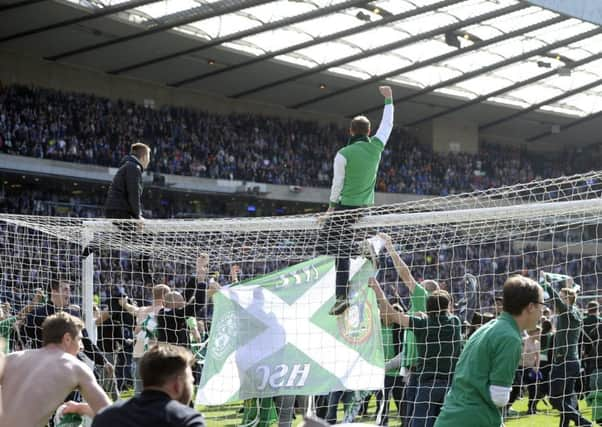Brian Monteith: Many questions raised by cup final inquiry


Just before 5.00pm last Friday evening, when the news headlines for that evening’s news broadcasts had mostly been dictated, the Scottish Football Association issued the independent report it had commissioned by Sheriff Principal Edward Bowen QC into the pitch invasion and resulting violence at the end of the Scottish Cup final on 21 May.
It also so happened to be the eve of the football season across the UK, where media attention and especially newspaper sports pages would be focusing expectantly on the first competitive matches and what they might throw up. To compound the distraction following on that evening would be the Rio 2016 Olympic games opening ceremony, with Andy Murray carrying the Union Flag on behalf of Team GB and the first competitions bringing news of the early medal winners.
Advertisement
Hide AdAdvertisement
Hide AdAs a public relations consultant I would find it hard to conceive of a more perfect storm of competing news stories and natural obstacles to release into the public domain a report on Scottish football policing and safety procedures that can only provoke as many questions as it answers.
Sheriff Bowen’s report clears the SFA, the Hampden Stadium management, the police, the stewards, and both Hibernian and Rangers football clubs of responsibility for the pitch invasion and the resulting scenes of mayhem.
He concludes that they held the necessary planning meetings, followed the appropriate guidelines, met their own anticipated staffing requirements, liaised with each other to everyone’s satisfaction and had no intelligence to suggest the cup final would end in the manner it did. The report explains the processes that were expected to be followed, in law and official guidance, and how these were met and sometimes even exceeded (such as having more stewards than required).
In absolving the authorities the finger of responsibility points to the individual fans that sought to cause trouble, first from the Hibs end of Hampden and then from the Rangers end. While Sheriff Bowen is careful to argue that the majority of Hibs supporters entered the playing area out of jubilant celebration he points to about 200 that crossed the half-way line intent on taunting opposing supporters and between 10-15 individuals intent on fighting.
Rangers fans are not left blameless, for their letting off of flares and singing sectarian songs throughout the game had caused police numbers to be concentrated at their end, weakening security at the Hibs end, and while the vast majority of Rangers supporters chose to leave the ground following the pitch invasion a significant number also accessed the pitch with the intention of clashing with Hibs supporters.
Sheriff Bowen’s conclusion that the operational procedures could not be blamed does not excuse the strategic failure.
The SFA and Police Scotland miscalculated their risk assessment of the possibility of a pitch invasion.
Sheriff Bowen makes this glaring failure obvious when he states, “I am not qualified to comment, nor would it be appropriate for me to do so, on the adequacy of the overall police numbers and the nature of their deployment.” Well, if he cannot then someone who can has to start a public debate.
Advertisement
Hide AdAdvertisement
Hide AdThe golden rule must be that no fans on the pitch means no ugly incidents and no need for an inquiry. How did the fans get on the pitch? Because the undermanned police – most of whom by the end of the game had moved to outside the stadium – told the stewards to allow supporters access to the playing area by opening the perimeter gates.
This was undoubtedly done with the best of intentions to avoid public disorder and the risk of public safety to innocent Hibs fans from a crush by their own following, such as happened at Hillsborough.
A change in approach to policing and stewarding must be the first step for without one we can expect the whole episode to be repeated and the next time the outcome in terms of violence could be far, far worse.
Imagine such numbers of Hibs supporters had come on to the pitch in genuine anger rather than jubilation? Imagine Rangers fans had invaded the pitch en masse rather than mostly choosing to leave the ground?
No fans on the pitch should have been a priority but instead allowing them on was a safety valve for a policing failure.
I have been to enough football matches in the last 50 years, many with huge crowds and an intimidating atmosphere of violence, to know that assured and thoughtful policing with adequate numbers can deter the madness of crowds. Stewards do not have the same legal rights that police do and were powerless to prevent the Hampden pitch invasion; using them to do the job of police officers is a false economy that puts safety at risk.
The end of match track detail, at only 52 police officers for the whole stadium was inadequate, and should in future be at least three times that number. If there is a cost to be borne then the showpiece finale that the Scottish Cup final represents should be able to carry it.
Not for the first time the Scottish Football Association has failed to meet its responsibilities, this time in its duty of care to supporters of both clubs. Will no-one hold it to account on behalf of the vast majority of decent football supporters who are powerless to effect change? Only the Scottish Government and the Scottish Parliament have the clout to intervene and be listened to. If they fail to act the next example of public disorder and possible tragedy will be their responsibility too, not just that of the football and policing authorities.
• Brian Monteith is a Hibernian FC supporter and former member of the Scottish Parliament who attended the Cup final